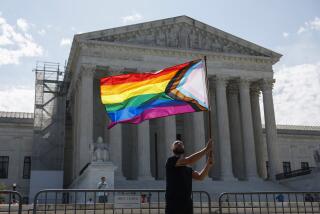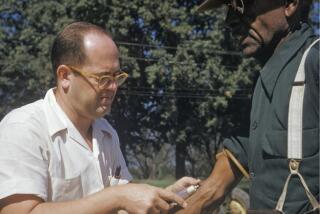Gay population - and anti-gay feelings - may be underestimated
- Share via
Far more people are lesbian, gay or bisexual – and more people are biased against them – than say so on typical surveys, a new study suggests.
The study, conducted by researchers from Ohio State University and Boston University and published by the National Bureau of Economic Research, found that even when filling out a private, anonymous survey, some people do not truthfully reveal their sexuality.
At the same time, researchers found that some people who believe employers should be able to discriminate against hiring gay, lesbian or bisexual people, or who dislike the idea of having a gay manager, also shy from revealing those attitudes on surveys.
The findings show that “it is perceived as socially undesirable both to be open about being gay, and to be unaccepting of gay individuals,” the researchers wrote. As a result, some people avoid putting those things down on surveys – even anonymously.
How could a study figure out what people weren’t telling them? Researchers compared how people answered questions on two different surveys, both of them answered online on their own computers.
In the typical survey, people were shown a list of “innocuous statements,” such as, “I spent a lot of time playing video games as a kid,” then asked to answer how many of them were true for themselves, giving an answer ranging from 0 to 4. They were then asked to answer yes or no to a separate question, such as “Do you consider yourself to be heterosexual?”
In the “veiled” method, a sensitive statement such as “I consider myself to be heterosexual” was included in the list of statements. That gave people an extra degree of secrecy if they answered yes: Someone might answer that two of the statements were true, for instance, but the researchers would have no way of knowing which ones they meant.
Researchers then used those results to estimate how many more people indicated they weren’t straight, using the veiled method.
A lot more people, researchers concluded: When they were asked directly, 11% of people said they did not consider themselves heterosexual, but using the veiled method, the estimated numbers hit 19%. Seventeen percent answered that they had a same-sex sexual experience; the veiled method turned up 27%.
When researchers used the same method to ask people about their attitudes toward lesbian, gay and bisexual people, they found more evidence that people weren’t revealing their true feelings: Sixteen percent said they wouldn’t be happy to have a boss who wasn’t straight, but the veiled method found a much higher number – 27%.
Only 14% said that hiring discrimination based on sexual orientation should not be illegal, using the typical survey; 25% were estimated to believe that using the veiled method.
Researchers cautioned that their results shouldn’t be used to extrapolate how many Americans are gay, lesbian or bisexual, since the survey was not nationally representative. (Young adults, for instance, were overrepresented.)
But the results raise questions about how surveys have tallied the gay community. And the fact that people shy from revealing their feelings about gay people, researchers added, “suggests that many other opinions on controversial public issues may not be accurately measured.”
ALSO:
Does it rain diamonds on Jupiter and Saturn?
Getting the point: African elephants understand human gestures
Study finds link between long-lived humans and species extinction






